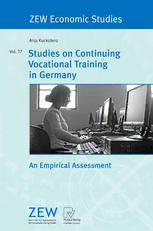
Studies on Continuing Vocational Training in Germany: An Empirical Assessment PDF
Preview Studies on Continuing Vocational Training in Germany: An Empirical Assessment
ZEW Economic Studies PublicationSeriesoftheCentrefor EuropeanEconomicResearch(ZEW), Mannheim,Germany ZEW Economic Studies Furthervolumesofthisseriescanbefoundatourhomepage: springer.com/series/4041 Vol.18:E.Wolf Vol.27:K.Jacobetal. WhatHampersPart-TimeWork? LeadMarketsfor AnEmpiricalAnalysisofWages,Hours EnvironmentalInnovations RestrictionsandEmploymentfroma 2005.XII,273pp.ISBN978-3-7908-0164-4 Dutch-GermanPerspective 2003.X,174pp.ISBN978-3-7908-0006-7 Vol.28:L.Lammersen,R.Schwager TheEffectiveTaxBurdenofCompanies Vol.19:P.Cecchinietal.(Eds.) inEuropeanRegions TheIncompleteEuropeanMarket 2005.XI,251pp.ISBN978-3-7908-1562-7 forFinancialServices 2003.XII,255pp.ISBN978-3-7908-0013-5 Vol.29:Ch.Elschner,R.Schwager TheEffectiveTaxBurden Vol.20:C.Böhringer,A.Löschel(Eds.) onHighlyQualifiedEmployees EmpiricalModelingoftheEconomy 2005.VIII,123pp.ISBN978-3-7908-1568-9 andtheEnvironment 2003.VI,326pp.ISBN978-3-7908-0078-4 Vol.30:Ch.Lauer EducationandLabourMarketOutcomes Vol.21:K.Rennings,T.Zwick(Eds.) 2005.IX,286pp.ISBN978-3-7908-1569-6 EmploymentImpactsofCleaner Production Vol.31:Ch.Böhringer,A.Lange(Eds.) 2003.VIII,322pp.ISBN978-3-7908-0093-7 AppliedResearchinEnvironmental Economics Vol.22:O.Bürgel,A.Fier,G.Licht 2005.VI,314pp.ISBN978-3-7908-1587-0 G.Murray TheInternationalisationofYoung Vol.32:O.Heneric,G.Licht, High-TechFirms W.Sofka(Eds.) AnEmpiricalAnalysisinGermany Europe´sAutomotiveIndustry andtheUnitedKingdom ontheMove 2003.XII,291pp.ISBN978-3-7908-0120-0 CompetitivenessinaChangingWorld 2005.XI,275pp.ISBN978-3-7908-1590-0 Vol.23:F.Hüfner ForeignExchangeIntervention Vol.33:Th.Hempell asaMonetaryPolicyInstrument ComputersandProductivity EvidenceforInflationTargetingCountries HowFirmsMakeaGeneralPurpose 2004.X,175pp.ISBN978-3-7908-0128-6 TechnologyWork 2006.X,194pp.ISBN978-3-7908-1647-1 Vol.24:E.Lüders EconomicFoundation Vol.34:D.Stegarescu ofAssetPriceProcesses DecentralisedGovernment 2004.XII,121pp.ISBN978-3-7908-0149-1 inaIntegratingWorld QuantitativeStudiesforOECDCountries Vol.25:F.Reize 2006.XI,231pp.ISBN978-3-7908-1669-3 LeavingUnemployment forSelf-Employment Vol.35:M.Meitner AnEmpiricalStudy TheMarketApproachto 2004.XII,241pp.ISBN978-3-7908-0168-2 ComparableCompanyValuation 2006.XII,241pp.ISBN978-3-7908-1722-5 Vol.26:Ch.Böhringer,A.Löschel(Eds.) Vol.36:S.L.Thomsen ClimateChangePolicyandGlobalTrade EvaluatingtheEmploymentEffectsof Job 2004.VIII,381pp.ISBN978-3-7908-0171-2 CreationSchemesinGermany 2007.X,234pp.ISBN978-3-7908-1949-6 Anja Kuckulenz Studies on Continuing Vocational Training in Germany An Empirical Assessment With13Figuresand65Tables Physica-Verlag ASpringerCompany SeriesEditor Prof.Dr.Dr.h.c.mult.WolfgangFranz Author Dr.AnjaKuckulenz CentreforEuropeanEconomicResearch(ZEW) L7,1 68161Mannheim Germany [email protected] LibraryofCongressControlNumber:2007929788 ISBN978-3-7908-1967-0Physica-VerlagHeidelbergNewYork Thisworkissubjecttocopyright.Allrightsarereserved,whetherthewholeorpartofthematerial is concerned, specificallythe rights of translation, reprinting, reuseof illustrations, recitation, broadcasting,reproductiononmicrofilmorinanyotherway,andstorageindatabanks.Duplication ofthispublicationorpartsthereofispermittedonlyundertheprovisionsoftheGermanCopyright LawofSeptember9,1965,initscurrentversion,andpermissionforusemustalwaysbeobtained fromPhysica-Verlag.ViolationsareliabletoprosecutionundertheGermanCopyrightLaw. Physica-VerlagisapartofSpringerScience+BusinessMedia springer.com ©Physica-VerlagHeidelberg2007 Theuseofgeneraldescriptivenames,registerednames,trademarks,etc.inthispublicationdoes notimply,evenintheabsenceofaspecificstatement,thatsuchnamesareexemptfromtherelevant protectivelawsandregulationsandthereforefreeforgeneraluse. Production:LE-TEXJelonek,Schmidt&V¨ocklerGbR,Leipzig Cover-design:WMXDesignGmbH,Heidelberg SPIN12079933 134/3180YL-543210 Printedonacid-freepaper Preface This study is an empirical assessment of continuing vocational training in Germanyanddiscusses determinantsandconsequencesoftraining.The work described in this dissertation was carried out at the Centre for European EconomicResearch(ZEW).IamverygratefultomysupervisorProf.Dr.Dr. h.c. mult. Wolfgang Franz, who supported and encouraged me throughout this work. I would like to thank him for always having a sympathetic ear to my questions and for very helpful assistance. I am also indebted to Prof. Dr. Walter Oechsler, who kindly accepted to be my second supervisor. My work benefited from discussions with him and his doctoral students. This work has been made possible through the financial support of the Deutsche Forschungsgemeinschaft (DFG) within the framework of the projects “Bildung und Verwertung von differenziertem Humankapital” and “BetrieblicheArbeitsnachfrageundQualifikationsanstrengungenauffriktionel- len und heterogenen Arbeitsm¨arkten”, which I gratefully acknowledge. This project is part of the DFG ResearchGroup “Heterogeneous Labour: Positive and Normative Aspects of the Skill Structure of Labour”, and I thank all research group members for productive discussions at several workshops. Ihavederivedenormouspersonalandscientificbenefitfrommytimespent at the ZEW, both from the people who work here and the environment that they have created. I thank my colleagues from the ZEW’s Department of Labour Markets, Human Resources and Social Policy for fruitful exchange of ideasonmethodologicalissuesaswellasgivingpreciousadviceoneconometric matters.The pleasantandconstructive workingenvironmentmade this piece of researchpossible. Moreover, I want to thank my co-authors Alfred Garloff, Michael Maier, and Thomas Zwick for great teamwork that made me enjoy doing research. Additionally,I liketo thankThomasZwickfor helpingme to getmy research work started and following it with support. My roommate Alfred Garloff fol- lowedallforwardas wellas backwardsteps of this workand alwayspatiently discussedthe mostvariousissueswith me.Nextto myco-authors,alsoFried- helm Pfeiffer, Martin Schu¨ler, and Alexandra Spitz were attentive referees of VI Preface (parts of) my first draft and gave valuable comments. Jenny Meyer, Iliyan Stankov,Diliana Stoimenova, and Tobias To¨nnesmann providedexcellent re- search assistance. All remaining errors are, of course, my own responsibility. Last but not least, I would mostly like to thank my family for consistent affection and support and Martin, who motivated me to get this work done. Mannheim, April 2007 Anja Kuckulenz Contents 1 Introduction............................................... 1 2 Continuing Training ....................................... 9 2.1 Theoretical Background: A Short Introduction to the Training Literature ...................................... 10 2.2 Institutional Background ................................. 11 2.2.1 Educational Policy ................................ 11 2.2.2 Legal Backgroundof Further Education .............. 12 2.2.3 Continuing Training as a Measure of Active Labour Market Policy..................................... 13 2.2.4 Financial Furtherance of Continuing Training ......... 14 2.2.5 Continuing Training in Collective Agreements......... 16 2.2.6 Suppliers of Further Education...................... 17 2.3 Some Stylised Facts...................................... 17 2.3.1 Training in Europe ................................ 18 2.3.2 Participation and Investment in Continuing Training... 20 2.4 Continuing Training in Empirical Research ................. 25 2.4.1 Introduction ...................................... 25 2.4.2 Data............................................. 26 2.4.3 Empirical Evidence................................ 30 2.4.4 Comparison of Results ............................. 45 2.4.5 Conclusion ....................................... 50 3 Heterogeneous Effects of Training on Earnings............. 53 3.1 Instrumental Variable Estimation.......................... 55 3.1.1 Introduction ...................................... 55 3.1.2 BackgroundDiscussion and Econometric Methods ..... 56 3.1.3 Endogeneity of Training............................ 58 3.1.4 Data............................................. 60 3.1.5 Descriptive Statistics .............................. 63 3.1.6 Empirical Evidence................................ 64 VIII Contents 3.1.7 Conclusion ....................................... 68 3.2 Sector Differences in Training Returns: The Case of Personal Services ................................................ 68 3.2.1 BackgroundDiscussion............................. 68 3.2.2 Data............................................. 71 3.2.3 Empirical Evidence................................ 72 3.2.4 Conclusion ....................................... 76 3.3 Non-Parametric Estimation: Local Instrumental Variables .... 77 3.3.1 Introduction ...................................... 77 3.3.2 BackgroundDiscussion............................. 78 3.3.3 Econometric Model................................ 80 3.3.4 Data............................................. 84 3.3.5 Implementation and Results ........................ 84 3.3.6 Conclusion ....................................... 86 3.4 The Influence of Different Training Types on Earnings ....... 87 3.4.1 Introduction ...................................... 87 3.4.2 Empirical Strategy and Results ..................... 88 3.4.3 Conclusion ....................................... 94 3.5 Summary of Results and Conclusion ....................... 94 4 Training, Mobility, and Wages: Specific Versus General Human Capital ............................................ 97 4.1 Introduction ............................................ 98 4.2 Derivation of Hypotheses and Estimation Strategy: Mobility Effect of Training and Wage Effect of Mobility ..............100 4.2.1 Mobility Effect of Training: Hypothesis Derivation.....100 4.2.2 Mobility Effect of Training: Estimation Strategy.......102 4.2.3 Wage Effect of Mobility: Hypothesis Derivation .......103 4.2.4 Wage Effect of Mobility: Estimation Strategy .........104 4.3 Data and Descriptive Evidence............................106 4.4 Empirical Results: Mobility Effect of Training and Wage Effect of Mobility........................................110 4.4.1 Mobility Effect of Training .........................110 4.4.2 Wage Effect of Mobility ............................111 4.5 Conclusion .............................................115 5 Comparison of Wage and Productivity Effect: A Sectoral Analysis ...................................................117 5.1 Introduction ............................................117 5.2 BackgroundDiscussion...................................118 5.3 Data Set ...............................................121 5.4 Descriptive Statistics.....................................123 5.5 Basic Model ............................................123 5.5.1 Estimation Strategy ...............................124 5.5.2 Empirical Results .................................128 Contents IX 5.6 Differentiation Between Low- and High-Skilled ..............136 5.6.1 Extension of the Model ............................136 5.6.2 Empirical Results .................................138 5.7 Conclusion .............................................139 6 Summary and Conclusion..................................143 Appendix......................................................149 A Further Tables and Figures for Chapter 2 ..................151 B Further Tables and Figures for Chapter 3 ..................171 C Further Tables and Figures for Chapter 4 ..................185 D Further Tables and Figures for Chapter 5 ..................193 E Glossary ...............................................197 List of Tables ..................................................201 List of Figures.................................................205 References.....................................................207
